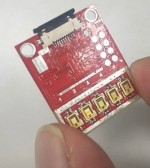Q&A with Shunichiro Kuroki: On Developing Odor-Imaging Sensors
May 29, 2018
on
on

C. J. Abate (Elektor Business): Are you an electrical engineer by trade?
Shunichiro Kuroki: No. I’m an ex-semiconductor process engineer, followed by Wall Street analyst covering the technology sector.
C. J.: Tell us about Aroma Bit’s compact sensor, which enables users to “see” a scent. How does the technology work?
Shunichiro: Aroma Bit’s compact odor-imaging sensor converts smell sample as digital pattern (Figure 1). The sensor consists of sensor substrate. We use QCM (quartz crystal microbalance) as a high-precision mass detector that detects mass changes in resonance frequency at the surface of quartz substrate. On each QCM element is a proprietary thin film, where each material has a different chemically affinity (for instance, high/low polarity, hydrophobicity/hydrophilicity, and so on). When odor reaches the QCM element surface and interacts, the mass change is detected as a change in frequency.

C. J.: Where are your sensors used? Who are your customers?
Shunichiro: One use case involves using our sensor in PR/marketing for gum commercials — a breath-checking robot that can detect a mint odor. Many others are currently in the evaluation phase from over 50 customers. Our customers include companies in a variety of industries, including food and beverage, cosmetics, automotive, home appliances, and healthcare.
C. J.: Has it been difficult to educate potential customers on the applicability of your technology?
Shunichiro: Some customers require education on the principle difference between conventional gas sensors (material detection of particular gases) versus odor sensing.
C. J.: About a year ago, you launched Milunio, an e-commerce website that features an odor visualization sensor that enables visitors to browse products by aroma. How does that work?
Shunichiro: Milunio contains two features that enable the site to browse product by aroma (Figure 2). The first feature is Aroma Code, which is basically a QR code for aroma. The Aroma Code contains smell information of a product. The smell information is expressed as relative sensor response data, as meta data to the product. The Aroma Code is obtained by premeasuring product samples with an aroma-imaging sensor. The sensor output data for each sample is converted to a visual pattern code and then stored in our product smell database. The second feature is an Aroma Search Engine, which takes the database data and ranks it. If one product is chosen, then you can find product with similar smell (similar pattern) online.

C. J.: Has the Milunio site been successful? Do you have plans to offer the service outside of Japan?
Shunichiro: We use Milunio as a technology to showcase of our innovation. We are currently in talks with global e-commerce companies. Over 60 sake companies and others — brewery, winery, coffee shop, and perfume — have their products registered in Milunio.
C. J.: What is Aroma Code?
Shunichiro: Aroma Code is basically the QR code of aroma. As I already explained, an Aroma Code is an objective, universal visual expression of a smell. It’s currently a 35-dot pattern with three degrees of freedom (small dot, medium dot, and large dot). The Aroma Code is obtained by pre-measuring product samples with an aroma-imaging sensor. The sensor output data for each sample is converted to a visual pattern code and then stored in our product smell database.
C. J.: Aroma Bit was selected to participate in STARTUP AUTOBAHN in Stuttgart, Germany, and to collaborate with DXC Technology. What can you tell us about the program and the collaboration?
Shunichiro: STARTUP AUTOBAHN is a three-month acceleration program provided by Plug and Play, one of the largest accelerators and venture capitalists. DXC selected Aroma Bit to collaborate for this program with the aim to build a prototype for particular target applications and customers.
C. J.: Does Aroma Bit have any new products or services in the pipeline? Where do you see the company in a year?
Shunichiro: Yes. We are currently developing several products for B2B customers, including a full spec desktop aroma analyzer and a portable terminal that can scan a variety of aromas.
Read past Elektor Business interviews
Read full article
Hide full article



Discussion (0 comments)